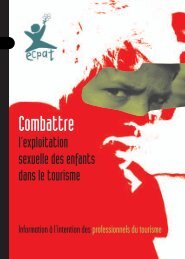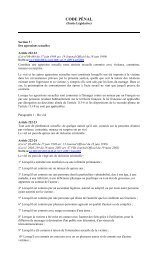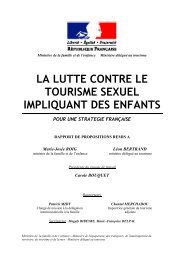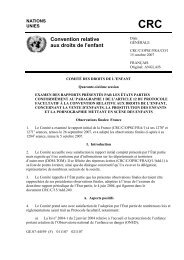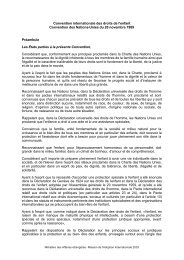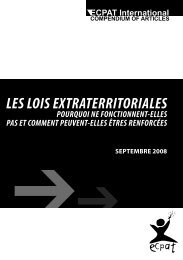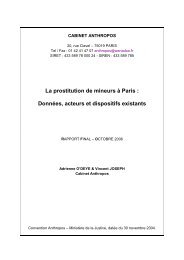child pornography and sexual exploitation of children online
child pornography and sexual exploitation of children online
child pornography and sexual exploitation of children online
Create successful ePaper yourself
Turn your PDF publications into a flip-book with our unique Google optimized e-Paper software.
as the Internet has become more available to a larger group <strong>of</strong> people, <strong>and</strong> the ability to<br />
access <strong>child</strong> <strong>pornography</strong> has become easier, so we are more likely to see the convictions<br />
<strong>of</strong> people who appear similar to the general population. A recent study by Middleton (in<br />
press) <strong>of</strong> 72 Internet sex <strong>of</strong>fenders found that, “It should also be noted that almost half <strong>of</strong><br />
the coded sample could not be assigned to any <strong>of</strong> the five aetiological pathways outlined<br />
by Ward <strong>and</strong> Siegert (2002). These individuals recorded no problems with intimacy or<br />
dealing with negative emotions, no distortions in their <strong>sexual</strong> scripts, <strong>and</strong> no anti-social<br />
cognitions, regarding the appropriateness <strong>of</strong> <strong>sexual</strong> contact with <strong>child</strong>ren, <strong>and</strong> yet have<br />
been prosecuted for using the Internet to access abusive images <strong>of</strong> <strong>child</strong>ren. This appears to<br />
suggest that there is a population <strong>of</strong> Internet <strong>of</strong>fenders who do not share the psychological<br />
vulnerabilities typically displayed by sex <strong>of</strong>fenders”. Middleton (in press) concludes that<br />
more research is needed, “to develop <strong>of</strong>fence specific assessment tools <strong>and</strong> in analysing<br />
the particular factors that can lead an individual from seeking to view indecent images <strong>of</strong><br />
<strong>child</strong>ren to moving into the commission <strong>of</strong> contact <strong>of</strong>fences”.<br />
Seto et al. (2006) suggested that <strong>child</strong> <strong>pornography</strong> <strong>of</strong>fending is a stronger diagnostic<br />
indicator <strong>of</strong> paedophilia than is <strong>sexual</strong> <strong>of</strong>fending against <strong>child</strong> victims. However, such a<br />
conclusion poses problems for us in how we make sense <strong>of</strong> the many thous<strong>and</strong>s <strong>of</strong> people<br />
who seem to be accessing abusive images <strong>of</strong> <strong>child</strong>ren every day. Those engaged in <strong>sexual</strong><br />
<strong>exploitation</strong> through the production, distribution <strong>and</strong> possession <strong>of</strong> abuse images may not<br />
be driven solely by their paedophilic interest but by other motives: or do we conclude from<br />
this that our underst<strong>and</strong>ing <strong>of</strong> the numbers <strong>of</strong> people who may be classified as paedophiles<br />
is a gross underestimate <strong>of</strong> the prevalence within the general population? Another possible,<br />
or at least partial, explanation for the results <strong>of</strong> this important study may lie in the nature<br />
<strong>of</strong> the stimuli themselves, <strong>and</strong> that for men who have spent long periods downloading <strong>and</strong><br />
accessing <strong>child</strong> pornographic images <strong>and</strong> masturbating to ejaculation to them, the visual<br />
stimuli themselves are highly salient, <strong>and</strong> perhaps more so than for men who use private<br />
fantasies or actual <strong>child</strong>ren as the focus <strong>of</strong> their arousal (Quayle, 2008). A more detailed<br />
discussion <strong>of</strong> the role <strong>of</strong> fantasy in both contact <strong>and</strong> Internet <strong>of</strong>fenders can be found in<br />
Sheldon <strong>and</strong> Howitt (2008).<br />
The section concludes by examining the, at times, conflicting research about the<br />
relationship between viewing abusive images <strong>and</strong> the commission <strong>of</strong> further <strong>of</strong>fences<br />
against <strong>child</strong>ren in both the <strong>online</strong> <strong>and</strong> <strong>of</strong>fline environments. There is a clear need for<br />
further research to explore the inherent aspects <strong>of</strong> the new technologies that appear to<br />
increase the likelihood <strong>of</strong> <strong>sexual</strong>ly exploitative <strong>and</strong> <strong>sexual</strong>ly abusive practices towards<br />
<strong>child</strong>ren in relation to the new technologies.<br />
38|Child Pornography <strong>and</strong> Sexual Exploitation <strong>of</strong> Children Online



